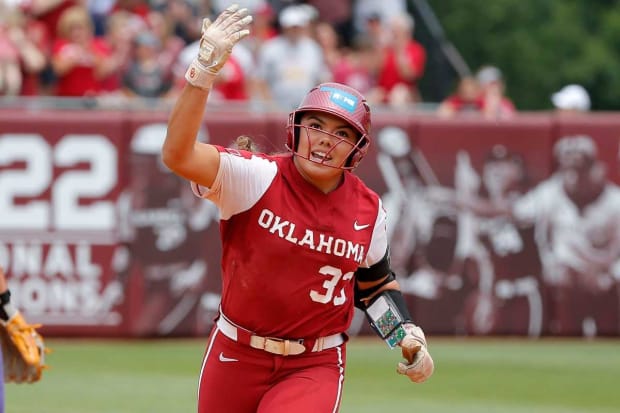When the Women’s College World Series championship kicks off Wednesday at 8 p.m. ET, No. 1 Oklahoma will try to cap a historic season with a third consecutive title, while No. 3 Florida State will do everything it can to prevent that.
Here’s the rundown for the best-of-three series.
Just How Good Is Oklahoma?
It’s almost impossible to understate it. This is potentially the best team in the history of the sport. The Sooners are 59–1 with a record 51-game win streak (and counting). It’s not just that they lead in a slew of key team stats, but that they do so by a ridiculous margin: Oklahoma has a .368 batting average while no other team is above .340 and a 0.98 ERA while no other team is under 1.50. The Sooners have hit 115 home runs this year while no one else has hit more than 100. Almost every statistic here sounds silly. They have shut out opponents 34 times this season. They average more than eight runs per game. They have three of the top 10 pitchers in the country by ERA—Nicole May, Jordy Bahl and Alex Storako—and they have threats all up and down their lineup. Their No. 9 hitter, Rylie Boone, has a .493 OBP.
So, yes, this team deserves every bit of the hype it’s received. There are no true weaknesses here. There are only areas that are somewhat less overpowering than others.

Sarah Phipps/USA Today Network
Is There Any Way Florida State Can Win?
Of course. The Sooners are incredible, but they aren’t unbeatable. The Seminoles know it is all but impossible to shut out the Sooners. But they can try to mitigate the damage.
“We want to limit back-to-backs and the amount of people that we allow on the bases,” Florida State catcher Michaela Edenfield said. “So if they do hit a home run—it’s bound to happen—but we want to minimize how many runs they get in that.”
The Seminoles’ pitching staff is far better equipped to do that than most: Fifth-year senior Kathryn Sandercock (1.05 ERA) and freshman Makenna Reid (0.89 ERA) are some of the few pitchers in the country who can go toe-to-toe with May, Bahl and Storako. And their offense is a fun contrast to that of the Sooners. This Florida State team loves small ball; they’re great bunters and tend to be active on the basepaths. They won’t be able to overpower the incredible pitchers on the Sooners. But if they can use their trademark style to string together just enough scoring, and Sandercock and Reid can combine to quiet Oklahoma’s offense much the way Stanford’s NiJaree Canady and Alana Vawter did in the semifinals on Monday, then a win is within reach.
It’s a lot of “ifs”. (And Florida State would have to do all of this twice.) But this Seminole team is here for a reason, and while the path for victory is narrow, demanding and perilous, it exists nonetheless.

SARAH PHIPPS/USA Today Network
What Happened When These Teams Played Earlier this Season?
The Sooners won. (Surprise.) But that March 14 contest was close—Oklahoma 5, Florida State 4.
Despite the slim margin of victory, Oklahoma’s pitching looked notably more powerful. Storako and Bahl combined to strike out 12 and allow six hits while Florida State needed to turn to Sandercock, Reid, Ali DuBois and Allison Royalty, who finished with a combined two strikeouts and 13 hits. But it’s also worth noting the context of that game for Florida State. It was the last game of a tough spring break road trip for the Seminoles; they played a three-game series against Oklahoma State, then ranked No. 3, before finishing it off with the one game against No. 1 Oklahoma. They went 1–3 on the trip. But the purpose of doing that in March was to get them ready to do it again with different results in June.
“A long road trip, it was tiring for the team, it was tough on us,” Florida State pitcher Kathryn Sandercock said. “We learned a lot about ourselves. I totally believe we wouldn’t be where we are now if we hadn’t had that experience. It’s nice to have a little bit of information, having already played them.”
In the end, though, none of that may ultimately matter very much at all. The WCWS is its own animal.
“We’re a different team than we were in March, as are they,” Oklahoma coach Patty Gasso said. “So we’re familiar with names and their style, but we’ve got to go back to the drawing board like we haven’t seen them before.”



















